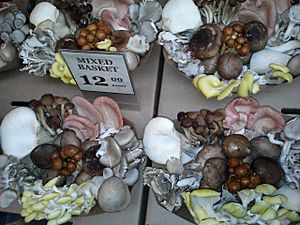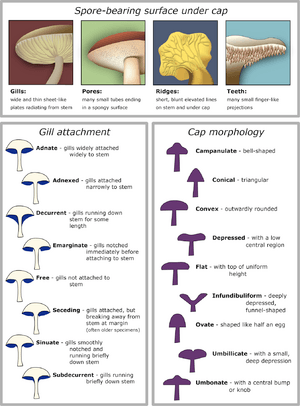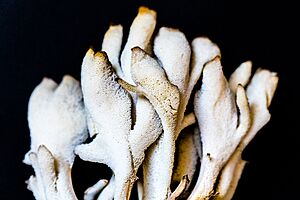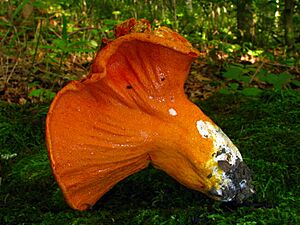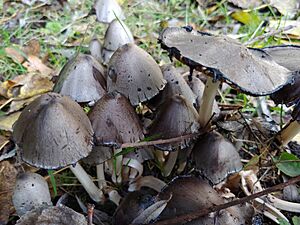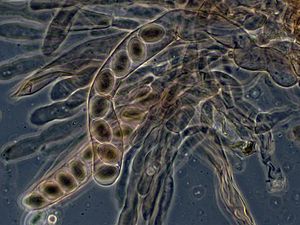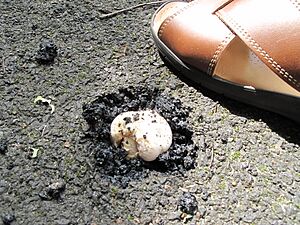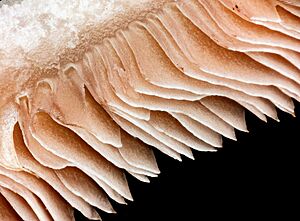Mushroom facts for kids
A mushroom is the part of a fungus that you can usually see above ground. It's often shaped like an umbrella and helps the fungus spread tiny spores. Sometimes, people call a mushroom a "toadstool," especially if it's poisonous.
The most common mushroom people know is the white button mushroom, called Agaricus bisporus. Most mushrooms have a stem (called a stipe), a cap (pileus), and thin layers underneath the cap called gills (lamellae). These gills produce microscopic spores, which are like seeds that help the fungus grow in new places.
Some fungi look different from typical mushrooms. They have special names like "bolete" (which has pores instead of gills), "puffball" (which is round), or "morel" (which looks like a sponge). The word "mushroom" can also refer to the entire fungus, including the hidden part underground called the mycelium.
Contents
Where Does the Word "Mushroom" Come From?

The words "mushroom" and "toadstool" have been around for hundreds of years. They didn't always have clear definitions. In the 1400s and 1500s, people used many different spellings for "mushroom," like mushrum or muscheron.
The word "mushroom" might come from the French word mousseron, which is related to moss (mousse). It's important to know that a "mushroom" can be edible, poisonous, or just not tasty. The word "toadstool" first appeared in England in the 1300s. It might have meant a "stool" for toads, suggesting it was a poisonous fungus.
How Do We Identify Mushrooms?
To identify a mushroom, you need to understand its basic parts. Most mushrooms are basidiomycetes and have gills. Their spores, called basidiospores, are made on these gills. They fall like fine powder from under the cap.
One helpful way to identify mushrooms is by making a spore print. You can cut off the cap and place it gill-side-down overnight. If the mushroom is releasing spores, it will leave a powdery print that shows the shape of the gills. The color of this print (like white, brown, black, or pink) helps scientists identify the mushroom.
Today, scientists use modern methods like DNA testing to identify mushrooms. But many people still use older methods. They look at things like:
- How the mushroom changes color when bruised.
- Its smell and taste (though tasting can be risky!).
- Its color and shape.
- Where it grows (its habitat).
- When it grows (its season).
Identifying a mushroom down to its exact species can be tricky. A mushroom changes as it grows from a tiny "button" to a full-grown one. You often need a mature mushroom to see all its features.
How Mushrooms Are Grouped
Most typical mushrooms belong to a group called Agaricales. The most famous genus in this group is Agaricus, which includes the common field mushroom. However, not all fungi that look like mushrooms are in this group. For example, chanterelles are in a different group called Cantharellales.
Some well-known mushrooms in the Agaricales group include:
- The common fairy-ring mushroom.
- Shiitake and enoki mushrooms.
- Oyster mushrooms.
- Fly agarics.
- Shaggy manes.
An interesting example of an unusual mushroom is the lobster mushroom. It's actually a regular mushroom that has been taken over by another fungus called Hypomyces lactifluorum. This makes it turn an unusual red color and look like a boiled lobster.
Many other fungi are also called "mushrooms" even if they don't have gills. Some have pores underneath, like boletes. Others have spines, like the hedgehog mushroom. The term "mushroom" is generally used for any larger, visible part of a fungus. There are about 14,000 different kinds of mushrooms known to science!
How Mushrooms Grow and Change
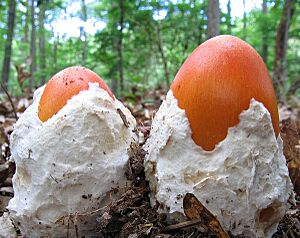
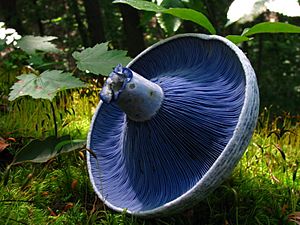
A mushroom starts as a tiny bump, less than two millimeters wide, called a primordium. This tiny bump grows from the mycelium, which is a network of thread-like parts of the fungus hidden underground or in its food source. The primordium grows into a round "button" shape.
Many mushrooms have a cottony layer called a universal veil that covers the young mushroom. As the mushroom grows, this veil breaks. Parts of it might stay at the base of the stem as a cup (called a volva) or as small bumps on the cap. Some mushrooms don't have this veil.
Another layer, called the partial veil, often covers the gills. When the cap opens up, this veil also breaks. It might leave a ring (called an annulus) around the middle of the stem.
The stem (also called the stipe) can be in the middle of the cap or off to the side. Some mushrooms, like polypores, don't have a stem at all and grow like shelves on trees. Puffballs are round and don't have a stem either.
The way the gills attach to the stem is an important clue for identification. Some mushrooms have "free gills" that don't touch the stem. Others have "decurrent gills" that run down the stem. There are many variations in between.
Tiny Details Under the Microscope
Mushrooms have a special layer called a hymenium where the spores are made. In mushrooms with gills, this layer covers the gills. In other fungi, it might line tubes or cover spines.
In some fungi, like Ascomycota, spores grow inside tiny, sac-like cells called asci. Each ascus usually holds eight spores. In Basidiomycota, usually four spores grow on club-shaped cells called basidia.
The spores themselves are very important for identification. Their color, shape, size, and how they react to chemicals can help scientists figure out what kind of mushroom it is.
How Fast Do Mushrooms Grow?
Many mushrooms seem to appear very quickly, sometimes overnight! This is why we say things "mushroom" when they grow fast. However, the tiny mushroom parts (primordia) actually take several days to form. Once they are formed, the mushroom can quickly absorb water from its mycelium and expand. It's like inflating a balloon!
For example, some mushrooms like Parasola plicatilis can grow to full size in just a few hours after rain. They release their spores and then collapse by the end of a hot day.
Not all mushrooms grow so fast. Some grow very slowly, adding new tissue over time. For instance, Pleurotus nebrodensis grows slowly, which is one reason it's now an endangered species.
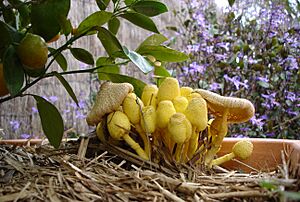
Even though the visible mushroom part is short-lived, the hidden mycelium underground can live for a very long time and become huge. One colony of Armillaria solidipes in the United States is thought to be 2,400 years old and covers an area of about 2,200 acres (9 square kilometers)! Most of this fungus is hidden underground, connecting decaying wood and tree roots.
What's in a Mushroom? (Nutrition)
| Nutritional value per 100 g (3.5 oz) | |
|---|---|
| Energy | 94 kJ (22 kcal) |
|
4.3 g
|
|
| Dietary fiber | 0.6 g |
|
0.1 g
|
|
|
Protein
|
2.5 g
|
| Vitamins | Quantity
%DV†
|
| Thiamine (B1) |
9%
0.1 mg |
| Riboflavin (B2) |
42%
0.5 mg |
| Niacin (B3) |
24%
3.8 mg |
| Pantothenic acid (B5) |
30%
1.5 mg |
| Vitamin B6 |
8%
0.11 mg |
| Folate (B9) |
6%
25 μg |
| Vitamin C |
0%
0 mg |
| Vitamin D |
1%
3 IU |
| Minerals | Quantity
%DV†
|
| Calcium |
2%
18 mg |
| Iron |
3%
0.4 mg |
| Magnesium |
3%
9 mg |
| Manganese |
7%
0.142 mg |
| Phosphorus |
17%
120 mg |
| Potassium |
15%
448 mg |
| Sodium |
0%
6 mg |
| Zinc |
12%
1.1 mg |
| Other constituents | Quantity |
| Water | 92.1 g |
| Selenium | 26 ug |
| Copper | 0.5 mg |
| Vitamin D (UV exposed) | 1276 IU |
|
Full Link to USDA Food Data Central entry; (exposed to UV light)
|
|
| †Percentages estimated using US recommendations for adults. | |
Raw brown mushrooms are mostly water (92%). They have some carbohydrates (4%), protein (2%), and very little fat (less than 1%). A 100-gram serving (about 3.5 ounces) of raw mushrooms has only 22 calories.
Mushrooms are a good source of several important nutrients:
- B vitamins: Like riboflavin, niacin, and pantothenic acid.
- Minerals: Such as selenium and copper. They also have some phosphorus, zinc, and potassium.
Mushrooms usually have very little vitamin C or sodium.
Vitamin D in Mushrooms
Mushrooms can also be a source of vitamin D. This happens when they are exposed to ultraviolet (UV) light, even after they've been picked! A substance in mushrooms called ergosterol turns into vitamin D2 when it gets UV light. This is why some mushrooms in stores are now specially treated with UV light to boost their vitamin D content.
How People Use Mushrooms
Mushrooms We Can Eat
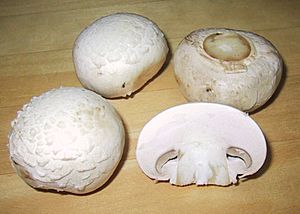
Mushrooms are used a lot in cooking around the world, especially in Chinese, Korean, European, and Japanese dishes. People have enjoyed eating them for a very long time.
Most mushrooms you buy in supermarkets are grown on special mushroom farms. The most popular one is Agaricus bisporus (white button, crimini, and portobello mushrooms). These are safe to eat because they are grown in clean, controlled places. Other types you might find include shiitake, maitake, oyster mushrooms, and enoki.
China is the biggest producer of edible mushrooms, growing about half of all cultivated mushrooms in the world. In 2014, Poland was the largest exporter of mushrooms.
It's very important to be careful when picking mushrooms in the wild. There's no simple rule to tell if a mushroom is safe or poisonous. People who collect wild mushrooms for food are called mycophagists. If you can't be absolutely sure what kind of mushroom it is, you should never eat it. Even edible mushrooms can sometimes cause allergic reactions in some people.
Mushrooms That Are Poisonous
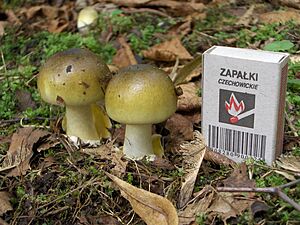
Many mushroom species produce chemicals that can be harmful. Some can make you very sick, and a few can even be deadly. These toxic chemicals likely help protect the mushroom from being eaten too soon.
It's also important to know that mushrooms can absorb heavy metals from the soil, including radioactive ones. For example, some European mushrooms were still found to have radioactivity from the 1986 Chernobyl disaster many years later.
Other Uses for Mushrooms
Mushrooms can be used to make natural dyes for wool and other fabrics. They can create strong, bright colors in almost every shade of the rainbow. Before artificial dyes were invented, mushrooms were an important source of color for textiles.
Some types of fungi, like polypores, have been used as "tinder" to start fires.
Scientists are also studying how mushrooms and other fungi can help the environment. They are looking into using them to help plants grow better or to clean up polluted water. There's also research into changing mushrooms using genetic engineering to make them even more nutritious or useful for medicine.
Images for kids
-
The Amanita muscaria mushroom, also known as "fly agaric."
-
Agaricus bisporus is a widely grown edible mushroom with names like "champignon" and "portobello."
-
Boletus edulis, also known as "cep," is an edible wild bolete found in Europe.
See also
 In Spanish: Seta para niños
In Spanish: Seta para niños


